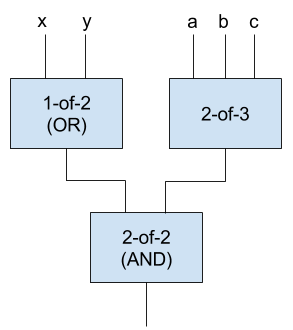Conditions¶
At a high level, a condition is like a lock on an output. If can you satisfy the condition, you can unlock the output and transfer/spend it. BigchainDB Server supports a subset of the ILP Crypto-Conditions (version 02 of Crypto-Conditions).
A condition object can be quite elaborate, with many nested levels, but the simplest case is actually quite simple. Here’s an example signature condition:
{
"details": {
"type": "ed25519-sha-256",
"public_key": "HFp773FH21sPFrn4y8wX3Ddrkzhqy4La4cQLfePT2vz7"
},
"uri": "ni:///sha-256;at0MY6Ye8yvidsgL9FrnKmsVzX0XrNNXFmuAPF4bQeU?fpt=ed25519-sha-256&cost=131072"
}
If someone wants to spend the output where this condition is found, then they must create a TRANSFER transaction with an input that fulfills it (this condition). Because it’s a ed25519-sha-256 signature condition, that means they must sign the TRANSFER transaction with the private key corresponding to the public key HFp773…
Supported Crypto-Conditions¶
BigchainDB Server v1.0 supports two of the Crypto-Conditions:
- ED25519-SHA-256 signature conditions
- THRESHOLD-SHA-256 threshold conditions
We saw an example signature condition above. For more information about how BigchainDB handles keys and signatures, see the page titled Signature Algorithm and Keys.
A more complex condition can be composed by using n signature conditions as inputs to an m-of-n threshold condition: a logic gate which outputs TRUE if and only if m or more inputs are TRUE. If there are n inputs to a threshold condition:
- 1-of-n is the same as a logical OR of all the inputs
- n-of-n is the same as a logical AND of all the inputs
For example, you could create a condition requiring m (of n) signatures. Here’s an example 2-of-2 condition:
{
"details": {
"type": "threshold-sha-256",
"threshold": 2,
"subconditions": [
{
"public_key": "5ycPMinRx7D7e6wYXLNLa3TCtQrMQfjkap4ih7JVJy3h",
"type": "ed25519-sha-256"
},
{
"public_key": "9RSas2uCxR5sx1rJoUgcd2PB3tBK7KXuCHbUMbnH3X1M",
"type": "ed25519-sha-256"
}
]
},
"uri": "ni:///sha-256;zr5oThl2kk6613WKGFDg-JGu00Fv88nXcDcp6Cyr0Vw?fpt=threshold-sha-256&cost=264192&subtypes=ed25519-sha-256"
}
The (single) output of a threshold condition can be used as one of the inputs to another threshold condition. That means you can combine threshold conditions to build complex expressions such as (x OR y) AND (2 of {a, b, c}).

When you create a condition, you can calculate its cost, an estimate of the resources that would be required to validate the fulfillment. For example, the cost of one signature condition is 131072. A BigchainDB federation can put an upper limit on the complexity of each condition, either directly by setting a maximum allowed cost, or indirectly by setting a maximum allowed transaction size which would limit the overall complexity accross all inputs and outputs of a transaction. Note: At the time of writing, there was no configuration setting to set a maximum allowed cost, so the only real option was to set a maximum allowed transaction size.
Constructing a Condition¶
The above examples should make it clear how to construct
a condition object, but they didn’t say how to generate the uri.
If you want to generate a correct condition URI,
then you should consult the Crypto-Conditions spec
or use one of the existing Crypto-Conditions packages/libraries
(which are used by the BigchainDB Drivers).
The Handcrafting Transactions page may also be of interest.